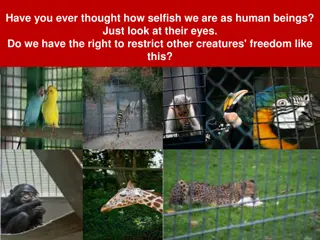The Agony of a Caged Tiger - Poem Analysis
The poem "A Tiger in the Zoo" by Leslie Norris contrasts the confinement of a caged tiger with its natural habitat in the jungle, highlighting the agony, pain, and helplessness of the imprisoned animal. The poet vividly describes the majestic tiger's physical attributes and behaviors, emphasizing how it should be roaming freely in the wild rather than being confined in a concrete cell. Through powerful imagery, the poem evokes a sense of empathy for the caged tiger and prompts reflection on the impact of captivity on wild animals.
Download Presentation

Please find below an Image/Link to download the presentation.
The content on the website is provided AS IS for your information and personal use only. It may not be sold, licensed, or shared on other websites without obtaining consent from the author.If you encounter any issues during the download, it is possible that the publisher has removed the file from their server.
You are allowed to download the files provided on this website for personal or commercial use, subject to the condition that they are used lawfully. All files are the property of their respective owners.
The content on the website is provided AS IS for your information and personal use only. It may not be sold, licensed, or shared on other websites without obtaining consent from the author.
E N D
Presentation Transcript
A TIGER IN THE ZOO - - Leslie Norris Leslie Norris
George Leslie Norris George Leslie Norris 21st May 1921 6th April 2006 Prize winning Welsh poet and short story writer. Published his 1st poem in 1938. His works have won him numerous awards. His publications include : Finding Gold The loud winder A Tiger in the Zoo The Collected Poems
The poem, Contrasts a tiger imprisoned in a cage with the tiger in its natural habitat. Explains the agony, pain and helplessness of a caged tiger. Compares his life to that of a free beast roaming in the jungle. The poem moves from the zoo to the jungle and again back to the zoo.
He stalks in his vivid stripes The few steps of his cage, On pads of velvet quiet, In his quiet rage. Difficult words : Stalks to move slowly Vivid very bright Stripes long lines on the body Pads of velvet (in the poem) the soft paws of the tiger. Rage anger The poet gives a description of a beautiful tiger with bright coloured stripes on his body. The tiger walks slowly taking few steps in the limited space. His paws are soft like velvet and he walks in silent anger as no one would understand the pain of being caged.
He should be lurking in shadow, Sliding through long grass Near the water hole Where plump deer pass. Difficult words : Lurking to be hidden waiting for its prey. Water hole water body or stream Plump fat / healthy Sliding moving swiftly The poet suggests that the cage is not the proper place for the tiger. He should be in the jungle hiding himself and waiting for his prey. He would slide silently through the long grass to catch a fat deer near a stream.
He should be snarling around houses At the jungle s edge, Baring his white fangs, his claws, Terrorising the village! Difficult words : Snarling: warning sounds made by animals Edge boundary/ outskirts Baring: uncover or to show Fangs: Sharp tooth of animals Terrorising scaring someone The poet again suggests that if the tiger was free, he would move around the house near the jungle s edge. He would make sounds to terrorize and scare the people of the village with his sharp tooth and claws.
But hes locked in a concrete cell, His strength behind bars, Stalking the length of his cage, Ignoring visitors. Difficult words : Concrete solid Ignoring take no notice strength power The poet returns back to reality and feels sorry for the tiger. The tiger is still caged behind strong concrete bars. He ignores the visitors as he cannot terrorize them since his strength and power is confined inside the cage.
He hears the last voice at night, The patrolling cars, And stares with his brilliant eyes At the brilliant stars. Difficult words : Patrolling cars cars used to guard or move around specific areas for security Brilliant very bright / shinny Stares to gaze The poet depicts that the tigers is unhappy and restless as he is unable to sleep. He hears the sounds of patrolling cars but shows no interest. He simply stares at the stars in the sky with his shinny eyes.
In this poem, The poet talks about a tiger which is very beautiful yet it confined and locked behind a concrete cell which makes the tiger feel helpless and sad . The poet also wants to convey the message that just like humans, animals also hate being caged and imprisoned . They should also be allowed to live in their natural habitat since they can only be happy there.
NCERT Questions Thinking about the poem : Q. No. 1 & 2. Extra Questions 1. It is said that an animal s eyes have the power to speak a great language. Explain with reference to the tiger. 2. How does the poem point at the cruelty towards animals in captivity. 3. State any three disadvantages that the Tiger have inside the zoo. 4. How does the Tiger create terror for the villagers?
























